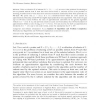Free Online Productivity Tools
i2Speak
i2Symbol
i2OCR
iTex2Img
iWeb2Print
iWeb2Shot
i2Type
iPdf2Split
iPdf2Merge
i2Bopomofo
i2Arabic
i2Style
i2Image
i2PDF
iLatex2Rtf
Sci2ools
JACM
1998
1998
A Threshold of ln n for Approximating Set Cover
Given a collection Ᏺ of subsets of S ϭ {1, . . . , n}, set cover is the problem of selecting as few as possible subsets from Ᏺ such that their union covers S, and max k-cover is the problem of selecting k subsets from Ᏺ such that their union has maximum cardinality. Both these problems are NP-hard. We prove that (1 Ϫ o(1)) ln n is a threshold below which set cover cannot be approximated efficiently, unless NP has slightly superpolynomial time algorithms. This closes the gap (up to low-order terms) between the ratio of approximation achievable by the greedy algorithm (which is (1 Ϫ o(1)) ln n), and previous results of Lund and Yannakakis, that showed hardness of approximation within a ratio of (log2 n)/ 2 Ӎ 0.72 ln n. For max k-cover, we show an approximation threshold of (1 Ϫ 1/e) (up to low-order terms), under the assumption that P NP. Categories and Subject Descriptors: F.2.2 [Analysis of Algorithms and Problem Complexity]: Nonnumerical Algorithms and Problems–Computatio...
| Added | 22 Dec 2010 |
| Updated | 22 Dec 2010 |
| Type | Journal |
| Year | 1998 |
| Where | JACM |
| Authors | Uriel Feige |
Comments (0)

